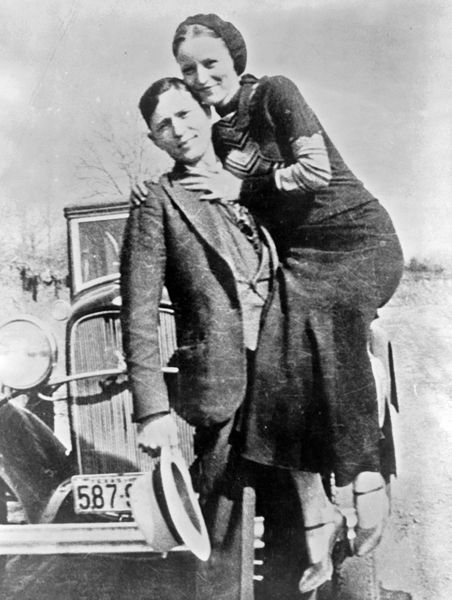
Bonnie and Clyde
Bonnie Elizabeth Parker (1910-1934) and Clyde Chestnut Barrow, aka Clyde Champion Barrow (1909-1934), were American criminals who traveled the central United States with the Barrow Gang during the Great Depression, robbing people and killing when cornered or confronted. The gang often included Clyde’s older brother Buck Barrow and his wife Blanche, Raymond Hamilton, W. D. Jones, Joe Palmer, Ralph Fults, and Henry Methvin. Their exploits captured the attention of the American public between 1931 and 1935.
Though known today for their dozen-or-so bank robberies, the two preferred to rob small stores or rural gas stations. The gang is believed to have killed at least nine police officers and several civilians. Bonnie and Clyde were shot to death by officers in an ambush near Sailes, Louisiana, on May 23, 1934, after one of the most colorful and spectacular manhunts the nation had seen up to that time.
The FBI, then called the Bureau of Investigation, became interested in Bonnie and Clyde in late December 1932 through a singular bit of evidence. A Ford automobile, which had been stolen in Pawhuska, Oklahoma, was found abandoned near Jackson, Michigan, in September of that year. At Pawhuska, it was learned another Ford car had been abandoned there, which had been stolen in Illinois. A search of this car revealed it had been occupied by a man and a woman, indicated by abandoned articles in the car. Also in the automobile was a prescription bottle, which led special agents to a drug store in Nacogdoches, Texas, where investigation disclosed the woman for whom the prescription had been filled was Clyde Barrow’s aunt.
Further investigation revealed that the woman who obtained the prescription had been visited recently by Clyde Barrow, Bonnie Parker, and Clyde’s brother, L.C. Barrow. It also was learned that these three were driving a Ford car, identified as the one stolen in Illinois. It was further shown that L.C. Barrow had secured the empty prescription bottle from the son of the woman who had initially obtained it.
On May 20, 1933, the United States Commissioner at Dallas, Texas, issued a warrant against Clyde Barrow and Bonnie Parker, charging them with the interstate transportation from Dallas to Oklahoma of the automobile stolen in Illinois. The FBI then started its hunt for this elusive pair.
Background
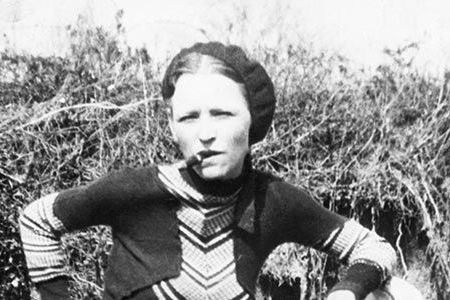
Bonnie Parker
Bonnie Elizabeth Parker was the second of three children, born in Rowena, Texas, to Charles and Emma Krause Parker on October 1, 1910. When she was four years old, her father passed away, and the family moved to Cement City, an industrial suburb now known as West Dallas, to live with her grandparents. In her second year in high school, Parker met a boy named Roy Thornton, and the pair dropped out of school and were married on September 25, 1926, six days before her 16th birthday. However, their time together was brief, as Thornton was physically abusive, and the two had several brushes with the law. In 1929, Thornton was sentenced to a five-year prison sentence for robbery, and Bonnie moved in with her grandmother. She would never see Thornton again, but they were never divorced, and Bonnie was wearing Thornton’s wedding ring when she died.
Clyde Chestnut Barrow was born into a poor farming family near Telico, Texas, a town just southeast of Dallas, on March 24, 1909. He was the fifth of seven children of Henry Basil Barrow and Cumie Talitha Walker. They eventually moved to West Dallas in the early 1920s, first living under their wagon. Clyde was first arrested in late 1926 after running when police confronted him over a rental car he had failed to return on time. He was arrested again when he and his brother, Marvin “Buck” Barrow, were in possession of stolen turkeys. Although he had legitimate jobs between 1927 and 1929, he was constantly involved in criminal activities.
Bonnie worked as a waitress in Dallas when she met Clyde Barrow through a mutual friend in January 1930. She was 19 years old, and Barrow was 20. Though Clyde was a volatile ex-con and a wanted man who had vowed that he would never return to prison, the two immediately began spending time together. However, their budding romance was interrupted when Clyde was arrested and convicted of several criminal charges pertaining to auto theft. While in jail, Bonnie smuggled a gun to him, and on March 11, 1930, he and his cellmates escaped. However, freedom would be short-lived as they were captured a week later. This time, Barrow was sentenced to 14 years of hard labor and sent to the Eastham Prison Farm in April 1930.
While in prison, Barrow used a lead pipe to crush the skull of another inmate, a man named Ed Crowder, who had repeatedly sexually assaulted him. This was Clyde Barrow’s first killing. However, another inmate serving a life sentence took the blame. Barrow then convinced another inmate to use an ax to chop off two of Barrow’s toes to excuse him from working hard labor in the fields, causing him to limp for the rest of his life. But Barrow could have saved his foot had he known that his mother was petitioning a release for him. Just six days after losing his toes, the petition was granted. He was paroled on February 2, 1932, leaving prison a changed man. One inmate would say he watched him “change from a schoolboy to a rattlesnake,” and his sister said: “Something awful sure must have happened to him in prison because he wasn’t the same person when he got out.”
Immediately upon his release, he rejoined Bonnie and resumed his life of crime. This time, however, he chose smaller jobs, such as robbing grocery stores and gas stations.
The Crime Spree Begins
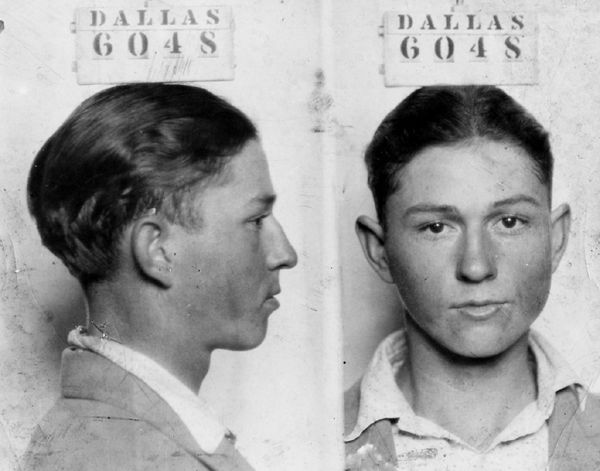
Clyde Barrow
Later, in 1932, Bonnie and Clyde began traveling with Raymond Hamilton, a young gunman. Hamilton left them several months later and was replaced by William Daniel Jones in November 1932.
Ivan M. “Buck” Barrow, brother of Clyde, was released from the Texas State Prison on March 23, 1933, having been granted a full pardon by the governor. He quickly joined Clyde, bringing his wife, Blanche, so the group now numbered five persons. This gang embarked upon a series of bold robberies that made headlines nationwide. They escaped capture in various encounters with the law. However, their activities made law enforcement efforts to apprehend them even more intense. During a shootout with police in Iowa on July 29, 1933, Buck Barrow was fatally wounded, and Blanche was captured. Jones, frequently mistaken for “Pretty Boy” Floyd, was captured in November 1933 in Houston, Texas, by the sheriff’s office. Bonnie and Clyde went on together.
The Bureau joined the chase for Bonnie and Clyde in 1933. Until then, they lacked the jurisdiction to get involved in what were local crimes. But in the spring of that year, they gathered evidence from a stolen car that had crossed state lines — and traced it to the elusive pair. That led to federal interstate car theft charges and enabled the FBI to officially join the manhunt in May 1933.
On November 22, 1933, a trap was set by the Dallas, Texas, sheriff and his deputies in an attempt to capture Bonnie and Clyde near Grand Prairie, Texas, but the couple escaped the officer’s gunfire. They then held up an attorney on the highway and took his car, which they abandoned in Miami, Oklahoma. On December 21, 1933, Bonnie and Clyde held up and robbed a citizen in Shreveport, Louisiana.
On January 16, 1934, five prisoners, including Raymond Hamilton (who was serving sentences totaling more than 200 years), were liberated from the Eastham State Prison Farm at Waldo, Texas, by Clyde Barrow, accompanied by Bonnie Parker. Two guards were shot by the escaping prisoners with automatic pistols, which had been previously concealed in a ditch by Barrow. As the prisoners ran, Barrow covered their retreat with bursts of machine-gun fire. Among the escapees was Henry Methvin of Louisiana.
The Last Months
On April 1, 1934, Bonnie and Clyde encountered two young highway patrolmen near Grapevine, Texas. Before the officers could draw their guns, they were shot. On April 6, 1934, the couple mortally wounded a constable in Miami, Oklahoma, and abducted and wounded a police chief.
The FBI had jurisdiction solely on the charge of transporting a stolen automobile, although the activities of the Bureau agents were vigorous and ceaseless. Every clue was followed. “Wanted notices” furnishing fingerprints, photographs, descriptions, criminal records, and other data were distributed to all officers. The agents followed the trail through many states and into various haunts of the Barrow Gang, particularly Louisiana. FBI agents discovered the association with Henry Methvin and the Methvin family of Louisiana, and they found that Bonnie and Clyde had been driving a car stolen in New Orleans.
On April 13, 1934, an FBI agent, through an investigation in the vicinity of Ruston, Louisiana, obtained information that placed Bonnie and Clyde in a remote section southwest of that community. The home of the Methvins was not far away, and the agent learned of visits there by Bonnie and Clyde. Special agents in Texas had learned that Clyde and his companion had been traveling from Texas to Louisiana, sometimes accompanied by Henry Methvin.
The FBI and local law enforcement in Louisiana and Texas concentrated on apprehending Bonnie and Clyde, whom they strongly believed to be in the area. It was learned that Bonnie and Clyde, with some of the Methvins, had staged a party at Black Lake, Louisiana, on the night of May 21, 1934, and were due to return to the area two days later.
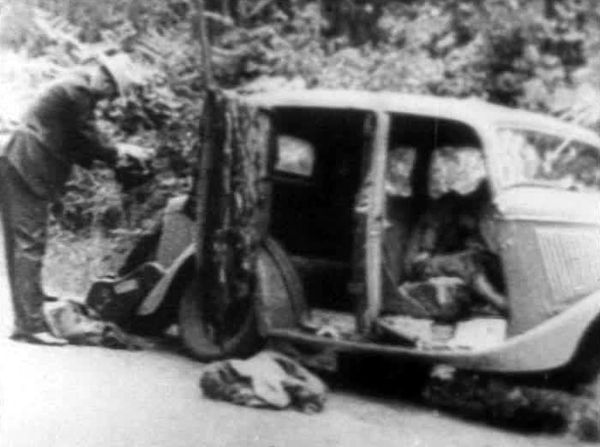
Bonnie and Clyde’s Car
Before dawn on May 23, 1934, a posse composed of police officers from Louisiana and Texas concealed themselves in bushes along the highway near Sailes, Louisiana. In the early daylight, Bonnie and Clyde appeared in an automobile, and when they attempted to drive away, the officers opened fire. Bonnie and Clyde were killed instantly.
In addition to the automobile theft charge, Bonnie and Clyde were suspects in other crimes. At the time they were killed in 1934, they were believed to have committed 13 murders and several robberies and burglaries. Barrow, for example, was suspected of murdering two police officers in Joplin, Missouri, and kidnapping a man and a woman in rural Louisiana. He released them near Waldo, Texas. Numerous sightings followed, linking this pair with bank robberies and automobile thefts. Clyde allegedly murdered a man at Hillsboro, Texas; committed robberies at Lufkin and Dallas, Texas; murdered one sheriff and wounded another at Stringtown, Oklahoma; kidnapped a deputy at Carlsbad, New Mexico; stole an automobile at Victoria, Texas; attempted to murder a deputy at Wharton, Texas; committed murder and robbery at Abilene and Sherman, Texas; committed murder at Dallas, Texas; abducted a sheriff and the chief of police at Wellington, Texas; and committed murder at Joplin and Columbia, Missouri.
After their deaths, Bonnie’s husband, Roy Thornton, still in prison, commented, “I’m glad they went out like they did. It’s much better than being caught.”
Clyde Barrow was buried in Western Heights Cemetery in Dallas, next to his brother, Marvin. The Barrow brothers share a single granite marker with their names on it and a four-word epitaph previously selected by Clyde: “Gone but not forgotten.”
Bonnie and Clyde wished to be buried side by side, but the Parker family would not allow it. She is buried elsewhere in Dallas.
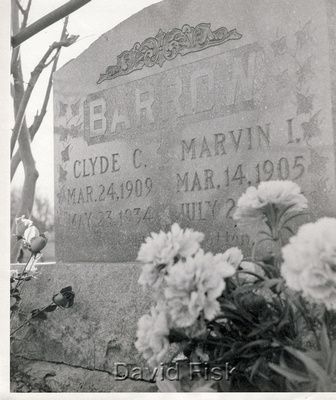
Clyde Barrow Grave, photo by David Fisk
© Kathy Alexander/Legends of America, updated October 2023.
Also See:
Frank Hamer – Stopping Bonnie & Clyde
Gangsters of the Prohibition & Depression Era
Sources:
